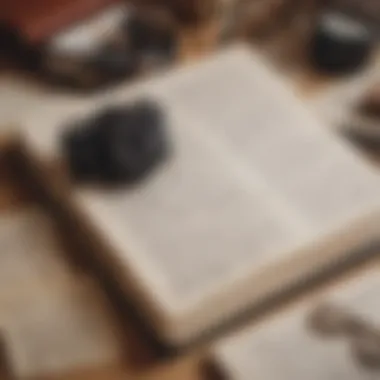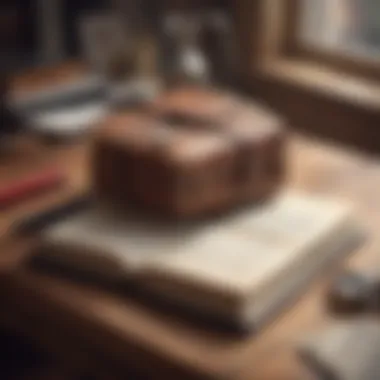Exploring the Charm of Vintage Locked Journals


Intro
Vintage journals with locks hold a special place in the tapestry of personal expression. They are not merely relics of times past; these journals represent a fusion of artistry, functionality, and nostalgia. The very act of journaling has transformed over the decades, yet the allure of tightly bound pages—secured with ornate locks—has remained steadfast. Each journal tells a story, not just through the words inscribed within, but also by its very design and craftsmanship.
Locking mechanisms were once critical for maintaining privacy, especially in eras where personal thoughts were kept hidden from prying eyes. This adds a layer of mystique, evoking curiosity about the secrets that lie within. With an increasing number of people yearning for tangible experiences in our digital world, vintage journals beckon them to slow down and embrace pen and paper, reigniting the lost art of handwriting.
As we explore the charm and practical significance of these journals, we will uncover the unique historical contexts, design elements, and the psychological benefits of documenting thoughts and experiences.
Fashion Trends and Insights
In the realm of vintage journals, it's interesting to recognize their intersection with contemporary fashion trends. Accessories are more than mere functional items; they convey individuality and style.
The Resurgence of Retro Styles
Currently, there's a noticeable shift back to retro aesthetics in both clothing and items like journals. Vintage journals with locks resonate with a growing desire for authenticity and uniqueness in one’s personal style. Collectors, designers, and everyday users alike appreciate items that have history and a story to tell.
- Key Factors Driving This Trend:
- Individuality: Today’s consumers want to stand out, and vintage items provide a unique flair.
- Sustainability: Choosing vintage often aligns with eco-conscious decision-making, encouraging a departure from fast fashion.
- Nostalgia: Many are drawn to memories and aesthetics from previous decades, often invoking personal storytelling through the items they choose.
Influential Figures and Movements
Across the globe, certain fashion icons have championed vintage style, including journals. They embrace relics that capture the essence of a time gone by. Designers often infuse the charm of vintage elements into their modern creations, sparking profound appreciation from diverse audiences.
In fashion movements, the adoption of vintage style is accompanied by an air of sophistication and an assertion of personal choices, which are powerful for the modern consumer. This encourages a deeper connection with objects such as vintage journals that serve not just as a diary but an artifact of style.
"Fashion is about making choices that reflect who you are. Vintage journals encapsulate that identity beyond the pages."
As we venture further into the subject of vintage journals, we will examine their design features, the craft behind their creation, and explore why they are hitting the spotlight in a fast-paced digital landscape.
Intro to Vintage Journals
Journals have long held a special place in the hearts of writers, dreamers, and collectors alike. Their ability to serve as a canvas for personal thoughts, a repository for creative work, or even a travel companion makes them not just tools, but cherished artifacts. Vintage journals, especially those adorned with locks, bring an added allure that transcends their practical use. The intricate craftsmanship and the stories they carry evoke a sense of nostalgia that is difficult to ignore.
Not only are these journals steeped in history, but they also serve as marvelous gateways into the past. They carry the weight of every thought penned within their pages, often aged yet resilient, illustrating the journey of human expression through time. For designers, retailers, and fashion enthusiasts, an appreciation for the artistry in these journals can lead to inspiration in their own creations—whether that be through patterns, textures, or color schemes.
The importance of vintage journals in today’s fast-paced world extends beyond mere aesthetics. They offer a personal touch that digital alternatives simply cannot replicate. In an age where technology often dominates, these physical objects allow for a tangible connection to one’s thoughts and feelings. Collectors find a unique joy in hunting down these hidden gems, seeking not only the beauty in their designs but also the stories behind them.
Thus, the allure of vintage journals with locks strikes a chord with many. They are symbols not only of a time gone by but also vehicles for personal expression, making them invaluable in a world that constantly yearns for authenticity. In the subsequent sections, we will delve deeper into the historical significance of journals as well as the functionality of their locks, exploring how these elements create a richer narrative.
Aesthetic Appeal of Vintage Journals
The aesthetic appeal of vintage journals transcends mere visual attraction. It's a confluence of artistry, craftsmanship, and a tangible connection to history. Each journal serves as a portal, inviting one to explore a personal narrative while simultaneously appreciating intricate design features. The look and feel of these journals resonate with a unique character, making them more than just writing tools. They bridge personal memories with artistic expression, striking a chord with those who appreciate both utility and beauty.
Design Elements in Vintage Journals
Materials Used
The materials used in crafting vintage journals significantly shape their identity and durability. Often made from leather, cotton, or recycled materials, these choices impact not only the feel but also the longevity of the journals. Leather offers a richness and robustness that appeals to many. Meanwhile, the use of natural fibers like cotton aligns with a more sustainable approach, attracting eco-conscious consumers.
Key Characteristics:
- Durability: Leather is resistant to wear, while cotton is breathable, often preventing mold.
- Visual Appeal: Each material carries a distinctive aesthetic, from the soft touch of cotton to the polished look of leather.
Advantages and Disadvantages:
- Leather, while beautiful, can be expensive.
- Cotton, while often more affordable, may not withstand heavy handling as well as leather.
Color Palettes
Color palettes in vintage journals play a pivotal role in their charm. Ranging from deep mahogany hues to soft pastels, these colors can evoke differing emotions and set the tone for what one might like to write about. The choice of colors often reflects the era they originate from, giving insights into the cultural context of the time.
Key Characteristics:
- Emotion Induction: Colors can inspire creativity or evoke nostalgia.
- Cohesion with Décor: Many opt for journals to complement their personal space, making hue an important consideration.
Advantages and Disadvantages:
- Dark colors can hide stains effectively but may fade over time.
- Light colors offer an inviting feel yet can show wear more noticeably.
Binding Techniques


Binding techniques used in vintage journals also add to their allure. From spiral to hand-stitched bindings, each technique influences how the journal lies flat when opened and its overall durability. Hand-stitched bindings, in particular, echo a commitment to craftsmanship that appeals to a consumer’s desire for authenticity.
Key Characteristics:
- Functionality: Certain binding styles allow for the journal to open easily, which can enhance the writing experience.
- Aesthetic Complexity: Some binders incorporate decorative threads that add visual interest.
Advantages and Disadvantages:
- Spiral bindings may allow for easy flipping but can be less elegant.
- Hand-stitched journals carry a unique charm but can be pricier to produce.
The Role of Embellishments
Gold Leaf
Gold leaf is often used to elevate the visual appeal of vintage journals. Its glimmering finish catches light, offering a luxurious touch that enhances the overall aesthetic. Historically, gold leaf serves not just as decoration but as an indication of status and importance.
Key Characteristics:
- Luxurious Appeal: The shimmer of gold leaf can make a simple journal feel extravagant.
- Durability: When applied correctly, gold leaf can endure the test of time without significant wear.
Advantages and Disadvantages:
- Gold leaf enhances visual appeal but can be more expensive to apply.
- If not protected, gold leaf can chip or scratch, impacting the journal's look.
Illustrations
Illustrations add a layer of storytelling to the journal's design. Whether through intricate floral patterns or whimsical sketches, illustrations provide a personal touch that often reflects the spirit of the era when they were created. They can inspire content and serve as visual prompts, encouraging creativity.
Key Characteristics:
- Personal Connection: Hand-drawn illustrations create a unique bond between the owner and the journal.
- Inspiration Source: These artworks can stimulate creativity, offering a rich backdrop for writing.
Advantages and Disadvantages:
- They can enrich the writing experience but are sometimes subject to fading over time.
- Illustrated journals may not appeal to those preferring a more minimalistic approach.
Textural Features
Textural features, such as embossed surfaces or handmade paper, contribute significantly to the tactile experience of using vintage journals. The texture invites touch and interaction, making the writing experience feel intimate and personal.
Key Characteristics:
- Enhanced Experience: Texture can turn the act of writing into a sensory experience, pulling the writer deeper into their thoughts.
- Variation: Each texture creates a unique canvas that can affect writing flow and style.
Advantages and Disadvantages:
- Textured surfaces can provide sensory delight but may require specific writing utensils to avoid bleeding or smudging.
- Some textures may not be suitable for heavy scribbling or erasing.
Purpose and Use of Vintage Journals
Vintage journals hold a special significance, acting as vessels for creativity, sentimentality, and personal expression. Their importance is not limited to aesthetics; they encapsulate the desire for documentation, nostalgia, and artistic exploration. Understanding the various purposes of these journals reveals their multifaceted nature, showcasing their relevance in both personal and communal settings.
Personal Documentation
Diary Entries
Diary entries present a pure, unfiltered way to express thoughts and emotions. They offer an interior glimpse into one's mind—capturing fleeting moments, wrestling with emotions, or charting personal growth. Vintage journals with locks elevate these entries, instilling a sense of privacy that encourages honest reflection. The key characteristic here is confidentiality; a lock serves as a physical barrier, prompting deeper honesty in writing, which is often hard to achieve in today’s digitally open world.
However, while diary entries in vintage journals can feel more intimate, they also carry the risk of being stored away and forgotten. The unique feature of these entries lies in how they can reveal patterns in life—trends in emotions or decisions—that are easily missed when written casually. The advantage here is this self-awareness, though it can pose a disadvantage if the entries become too focused on negativity or are left unread for long.
Creative Writing
The creative writing space in vintage journals is another realm where imagination unfurls beautifully. Writers often find inspiration flourishing amidst paper that has seen countless thoughts before. The tactile feel of aged pages and the weight of a lock foster an atmosphere imbued with mystery and potential—a setting where ideas feel more powerful. The key characteristic that sets creative writing apart in these journals is the personal connection forged between the writer and their pen.
Many writers find joy in the imperfections of vintage journaling, where one can doodle, erase, or jot down ideas without concern for polished output. The unique feature of this creative engagement in vintage journals lies in the sheer authenticity of the writing process; however, it could also lead to cluttered ideas and unfinished stories being left behind if not managed well. Still, the freedom it offers can inspire deep and meaningful creations.
Travel Logs
Travel logs in vintage journals take on a special significance as they document adventures and experiences. Capturing memories of places visited, people met, and insights gained can turn a simple trip into a profound narrative. What stands out in travel logs is their ability to chronicle not just the journey, but the transformation that occurs through travel. The key characteristic of a travel log is its storytelling potential—each entry acts as a portal to another time and place.
In these accounts, the unique feature is the inclusion of sketches, ticket stubs, or pressed flowers. These embellishments can make the log more than just a written account; they become a tactile representation of experiences. Yet, in the rush of adventure, some may neglect to document all details, potentially missing out on capturing the essence of a trip.
Gift Giving and Collecting


Vintage journals also serve significant roles beyond personal uses. Their allure extends to gift giving and collecting, where their value can be both sentimental and monetary.
Sentimental Value
Sentimental value is a core aspect of why vintage journals are cherished as gifts. When gifted, they carry personal stories and connections, often becoming touchstones of shared experiences. The key characteristic of sentimental value is the emotional bond it creates between the giver and the recipient. For many, receiving a vintage journal signifies the sharing of one’s own narratives and trust.
One unique feature here is how journals can hold legacy—family histories inscribed within, preserving the past for future generations. While they bring joy and warmth, a disadvantage could be the pressure of how to fill those pages meaningfully, especially for less experienced writers.
Collector's Items
When it comes to collecting, vintage journals can attract enthusiasts who appreciate the art of the craft. These journals often become collector’s items, each telling an aspect of history with every page turned. The key characteristic of these items is their investment potential; collectors value the rarity, condition, and past ownership of these journals.
The unique feature is that a collection can symbolize various eras, styles, and influences in the world of stationery. However, the disadvantage may lie in the market's volatility—prices can fluctuate based on trends and demand, making it a mixed venture.
Custom Gifts
In a realm where personalization reigns supreme, custom vintage journals capture the eyes of those seeking unique gifts. Customization options allow for names, dates, or special messages engraved into the cover, making them sought after for occasions like birthdays or anniversaries. The key characteristic here is individuality; they showcase thoughtfulness that imparts warmth.
The unique feature of custom vintage journals is their potential to reflect personal stories. However, quick custom options can sometimes lead to quality compromises, risking the journal becoming more generic than intended.
The blend of emotional and tangible attributes means that vintage journals fulfill diverse purposes—each story or memory documented can resonate through time, ensuring they remain relevant aids for individuals now and in the future.
Nostalgia and Vintage Aesthetics
Nostalgia plays a powerful role in shaping our appreciation for vintage journals, especially those adorned with locks that whisper of secrets and times gone by. This emotional response connects individuals to the past, evoking feelings of sentimental longing that many find comforting. The vintage aesthetic encompasses not just a specific design, but also an experience and a way of seeing the world, which has a special resonance in today's fast-paced life.
The appeal of nostalgia has a psychological foundation as it provides an anchor in a world that often feels chaotic. When individuals engage with vintage items, such as journals, they are taping into a connection that transcends generations and offers a moment of reflection. Vintage journals with locks can signify safety and privacy, amplifying the notion that one's thoughts and experiences are not merely entries on a page, but cherished possessions that deserve protection.
The Psychological Appeal of Nostalgia
Understanding the psychological allure of nostalgia opens a window into why vintage journals have such lasting appeal. Nostalgia often acts as a balm, soothing anxiety and fostering a sense of belonging. This sense of belonging can stem from the familiar designs, materials, and craftsmanship that often characterize vintage journals. It feels like revisiting a warm memory or flipping through the pages of an old family photo album.
Furthermore, nostalgia can enhance creativity. When writers and artists engage with vintage journals, they may find themselves inspired by the textures, colors, or the very act of writing with a pen brushed against the fibers of aged paper. It becomes not just an act of documentation but a form of personal expression where the past influences the present. The tactile experience of these journals fosters a deep connection that digital tools often lack.
Influence of Nostalgia in Fashion
Nostalgia's influence doesn’t stay confined to the realms of personal documentation; it spills over into fashion and design in profound ways. The resurgence of vintage-inspired styles showcases how designers are borrowing elements from the past to create modern pieces that resonate with consumers.
Incorporating vintage aesthetics can involve:
- Materials: Many designers look to traditional materials that evoke a sense of nostalgia such as leather, waxed canvases, and textured fabrics. The tactile nature of such materials adds depth to the experience.
- Color Palettes: Earthy tones, muted pastels, and deep colors often result in collections reminiscent of certain eras, serving as a visual retreat.
- Silhouettes: Vintage cuts and styles gain popularity, creating pieces that feel timeless and familiar while catering to new audiences.
This blend of the old with the new reinforces a sense of identity and allows consumers to tell their stories through what they wear. Vintage journals with locks embody this spirit, not merely as objects for writing but as symbols of an era reimagined in our current lives.
By embracing nostalgia, both consumers and creators alike find a bridge between the past and present, resulting in an ongoing dialogue that informs personal style and creative expression.
Modern Interpretations of Vintage Journals
The resurgence of interest in vintage journals reflects a broader appreciation for craftsmanship and history in our modern lives. While the past offers a wealth of inspiration, blending old-world charm with contemporary designs can create journals that resonate on multiple levels. Not only do these hybrid creations appeal aesthetically, but they also serve as a canvas for personal expression in our fast-paced, digital world.
Fusion of Old and New Designs
The mixing of traditional and modern elements in vintage journals is akin to a dance, where each partner brings their unique style to the floor. Designers are increasingly taking cues from classic designs, resurrecting features like intricate engravings and durable bindings while integrating innovative materials like eco-friendly paper or vegan leather. This marriage of styles allows for journals that are visually captivating and practical for everyday use.
For instance, a journal may sport the vintage facade of a Victorian-era cover while sporting modern, minimalist interiors for clean lines that appeal to today’s user. This fusion ensures that each piece becomes a conversation starter, holding stories from both the past and present within its pages.
"The charm of a vintage look can often be enhanced by a modern twist, making each journal not just a repository of thoughts but also a piece of art."
Sustainability and Vintage Appeal
In today’s world, sustainability isn't just a buzzword; it's a necessary consideration. Vintage journals, especially those made from recycled or repurposed materials, align perfectly with eco-conscious values. By choosing to invest in these pieces, one is not only acquiring an item steeped in history but also promoting environmental responsibility.
Moreover, the very essence of a vintage journal lies in its story. Many of these journals are crafted using time-honored techniques, devoid of the mass production methods so commonly used today. The focus on quality over quantity results in durable items that can withstand the test of time. Consumers are drawn to the idea of owning not just a product, but a piece of history that resonates with their views on sustainability.
Key Benefits:
- Unique Character: Each vintage journal has its distinctive charm, reflecting years of craftsmanship that mass-produced items lack.
- Eco-Friendly Choices: They often utilize sustainable materials and methods, providing an alternative to conventional production practices.
- Investment in Heritage: Owning a vintage journal transforms the mundane act of journaling into a connection with the past.
The ability to intertwine the old with the new, along with a strong committed to sustainability, truly enhances the appeal of vintage journals in the modern landscape. They are not merely relics of the past; they are functional art pieces designed to enrich our daily lives.
As designers, retailers, and influencers propel this trend, anyone with an eye for the exquisite can find a vintage journal that resonates with their personal style and values.
How to Choose a Vintage Journal


Choosing a vintage journal is much like selecting a companion—you want it to resonate with you and serve its purpose well for years to come. It requires a thoughtful approach, combining personal taste with practical considerations. A vintage journal is not merely a notebook; it’s a vessel for your thoughts and creativity, a piece of art with its history. To navigate this world effectively, you should keep in mind a few key elements that can significantly influence your decision.
Factors to Consider
Condition
When examining vintage journals, condition matters a whole lot. A journal in good condition speaks to its longevity and usability. Look for one where the spine is intact and pages aren't yellowed or torn—though some wear can add charm. A journal in prime shape means you can write in it without worrying about it falling apart. Also, a journal that shows signs of use tells a story, perhaps harboring old pencil marks or an inscription, which adds to its character.
If you're looking for practical use, choose one where the pages are pliable and can handle ink well without bleeding. However, if the charm of aged wear attracts you, an older, more worn journal can also be a wonderful find. Just remember, you might need to handle it with a bit more care.
Genuine Vintage vs. Reproduction
The choice between genuine vintage and reproduction journals can sway your decision-making. Genuine vintage journals carried stories through time, making them unique. Their authenticity can enhance aesthetic appeal, and there's a satisfying thrill in owning something with a history. However, they may come with imperfections that can affect usability.
On the other hand, reproductions might lack the historical weight but can offer a polished design for those who want aesthetics without compromising on functionality. Think of reproductions like tailored suits—it might not have the storied past, but the fit can be spot-on. Knowing what you value—history or usability—will guide your choice here.
Price Points
Price certainly factors in when selecting a vintage journal. Budget goes hand-in-hand with your vintage hunt. Generally, a genuine vintage journal can set you back a bit more due to its historical value. However, if you're facing a tight budget, it doesn’t mean you can’t find hidden gems; a little patience goes a long way.
Reproductions are often more affordable, and you can find lovely ones that mimic true vintage styles without breaking the bank. Consider what you're willing to invest, balancing your passion for the aesthetic charm and the functionality you need.
Where to Find Vintage Journals
There are several treasure troves to find vintage journals, each with its unique flavor. Knowing your options can enhance your chances of stumbling upon that perfect piece.
Antique Stores
Antique stores often house a diverse variety of journals, each with a tale to tell. Here, the thrill is in the hunt—you might come across something unexpected. The tactile experience of flipping through pages in person is irreplaceable. You can ask the shopkeepers questions about the journals' histories, something a screen often lacks. However, prices can be on the higher side, and inventory is unpredictable, so visiting often pays off.
Online Marketplaces
Online marketplaces have changed the game. Websites like eBay and Etsy make browsing from the comfort of your home a breeze. You can find a broader selection and even filter results by price. However, exercise caution—always check seller ratings and look closely at photos to avoid surprises. Occasionally, you might miss out on the thrill of in-person discovery and the true condition of the journal.
Estate Sales
Estate sales can yield some of the most intriguing finds. These sales often contain journals overflowing with stories, personal writings, or sketches. It’s a bit like walking through history, finding pieces that might be lost to time otherwise. The prices are typically more reasonable, reflecting the need to move items quickly. Just be prepared to dig through, as treasures may be scattered among less appealing items, demanding time and effort to uncover.
Maintaining and Preserving Vintage Journals
Maintaining and preserving vintage journals is not just about keeping a collection intact; it’s about safeguarding a piece of history, a fragment of personal expression, and a tangible connection to the past. Vintage journals, especially those with locks, carry an allure that transcends mere aesthetics. Their charm lies in the stories they contain, the memories they guard, and the craftsmanship that brought them to life. Thus, understanding how to properly care for these treasured objects is fundamental for enthusiasts and collectors alike.
Proper Storage Techniques
When it comes to storage, how you treat your vintage journals can make all the difference. Proper storage techniques are directly tied to the longevity of these beautiful items. Here are some key considerations:
- Climate Control: Ensure that journals are stored in a temperature-controlled environment. Extreme heat or humidity can warp pages and damage bindings. Aim for a cool, dry place to avoid any unwanted surprises.
- Avoid Direct Sunlight: Light can fade colors and deteriorate materials over time, so always keep your journals away from direct sunlight. A dark shelf or cabinet works best.
- Use Acid-Free Materials: For additional protection, consider using acid-free boxes or sleeves. This helps prevent acidic degradation of paper, which can turn pages brittle and yellow.
"The right storage goes a long way in preserving the life of your journals; they deserve a gentle touch."
- Keep Locks Functioning: If your journal has a lock, avoid unnecessary strain. Ensure it functions smoothly to prevent jamming or breaking, which can be costly to fix.
Storing vintage journals thoughtfully not only protects their physical integrity but also keeps their stories alive for future generations.
Restoration Tips
Restoration is an art form in itself, one that should be approached with care and consideration for the journal's historical value. Here are some tips for restoring vintage journals:
- Assess the Condition: Take a good look at the journal's condition before beginning restoration. Identify pages that need repairs or binding that requires reinforcement. Knowledge is power here.
- Use the Right Materials: When repairing pages or binding, use archival-quality adhesive and materials. Regular glue can cause further damage over time.
- Gentle Cleaning: If the cover or pages are dirty, clean them gently with a soft cloth or brush. Avoid harsh chemicals which can cause discoloration or degradation.
- Consider Professional Help: For valuable or significantly damaged journals, seeking professional restoration services might be the best route. They have the expertise to restore without compromising the journal's integrity.
- Document the Restoration: Keep notes about any restoration work you undertake. This creates a timeline and history for the journal, which can be significant for future ownership.
Restoration isn’t just about fixing; it’s about honoring what the journal represents. Taking the time to restore vintage journals properly ensures their stories remain vibrant for years to come.
Epilogue: The Lasting Appeal of Vintage Journals
The fascination with vintage journals, particularly those adorned with locks, rests not solely in their aesthetic beauty but also in their multifaceted roles in our lives. This concluding section examines their enduring significance, emphasizing the timelessness of such journals in our fast-paced, technology-driven world. Although modern devices enable us to jot down thoughts at lightning speed, vintage journals remind us of the slower, intentional act of writing. They evoke a sense of nostalgia, rooting us in a richer, tactile experience that digital formats simply can’t replicate.
Timelessness in Modern Life
Today, amid ubiquitous screens, the allure of tangible items persists. Vintage journals embody a nostalgia that resonates deeply. Their handcrafted details—from the grain of the leather to the intricate lock mechanism—speak of artistry that high-tech gadgets lack. These journals serve as a counterbalance to modernity; where digital records vanish with a click, the thoughts penned into vintage journals become permanent artifacts of our lives.
The revival of vintage styles in fashion and design underscores this trend. Designers and consumers alike are gravitating towards authentic pieces that tell a story. Vintage journals fit seamlessly into this narrative, appealing as tools for self-reflection and creativity that enhance personal style. For many, writing in a vintage journal isn't merely about recording facts—it's about embracing the sensorial experience of ink meeting paper, the flutter of pages, and the satisfying click of a lock that keeps secrets safe.
Personal Connection to Writing
The relationship between a writer and their journal is a deeply personal one. Vintage journals, especially those with locks, create a unique sanctuary for thoughts, fears, and dreams. The act of writing becomes sacred, transforming mundane thoughts into a profound narrative woven into the fabric of one’s history.
There’s something uniquely empowering in knowing that your words are protected by a lock. It invites an intimacy and vulnerability that often encourages deeper introspection. For many, the frightening yet cathartic process of writing is enhanced by the knowledge that these thoughts are well-guarded, whether from prying eyes or even from our own self-doubt.
As one peruses a shelf of vintage journals, it’s easy to feel the pull of their untold stories. They offer not just a canvas but a companion for our thoughts and creativity. They are a bridge—a means of connecting past, present, and future, allowing each writer to create a legacy that is as personal as it is artistic. As we reflect on their timeless appeal, it becomes clear that these journals are not just relics of a bygone era; they are vessels for personal expression that hold a place in our modern lives.



